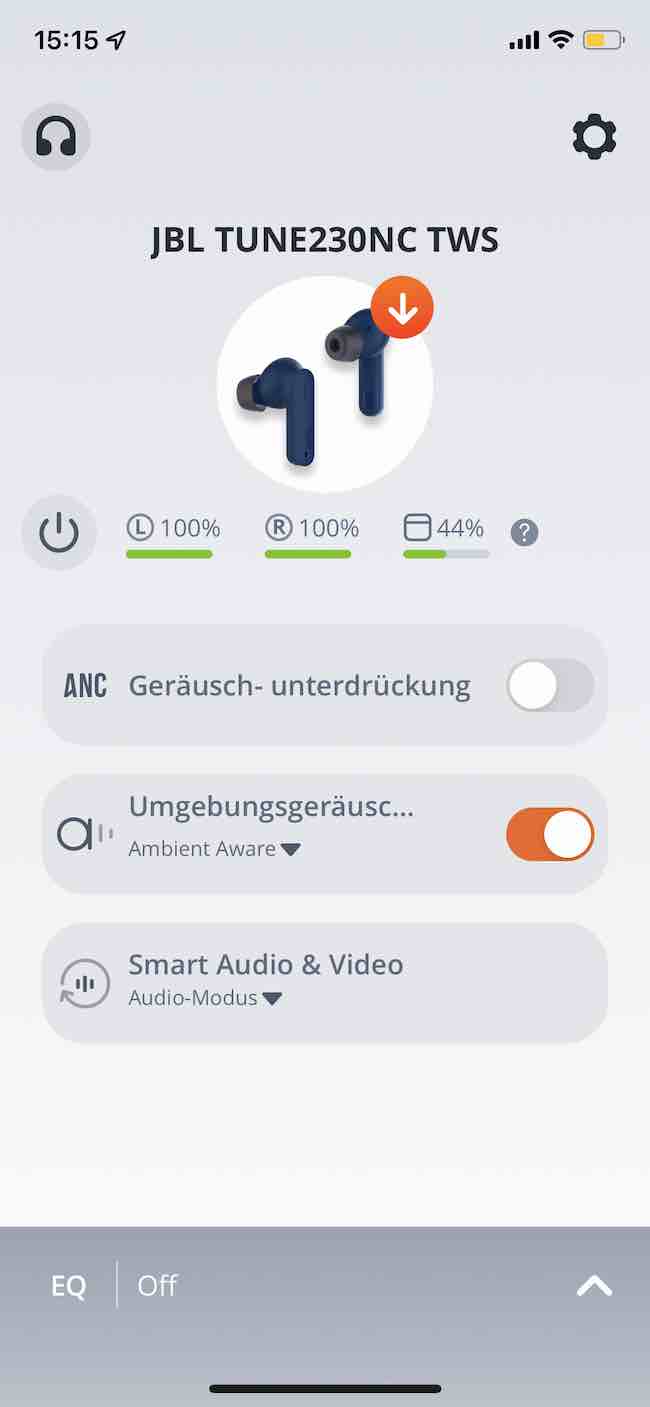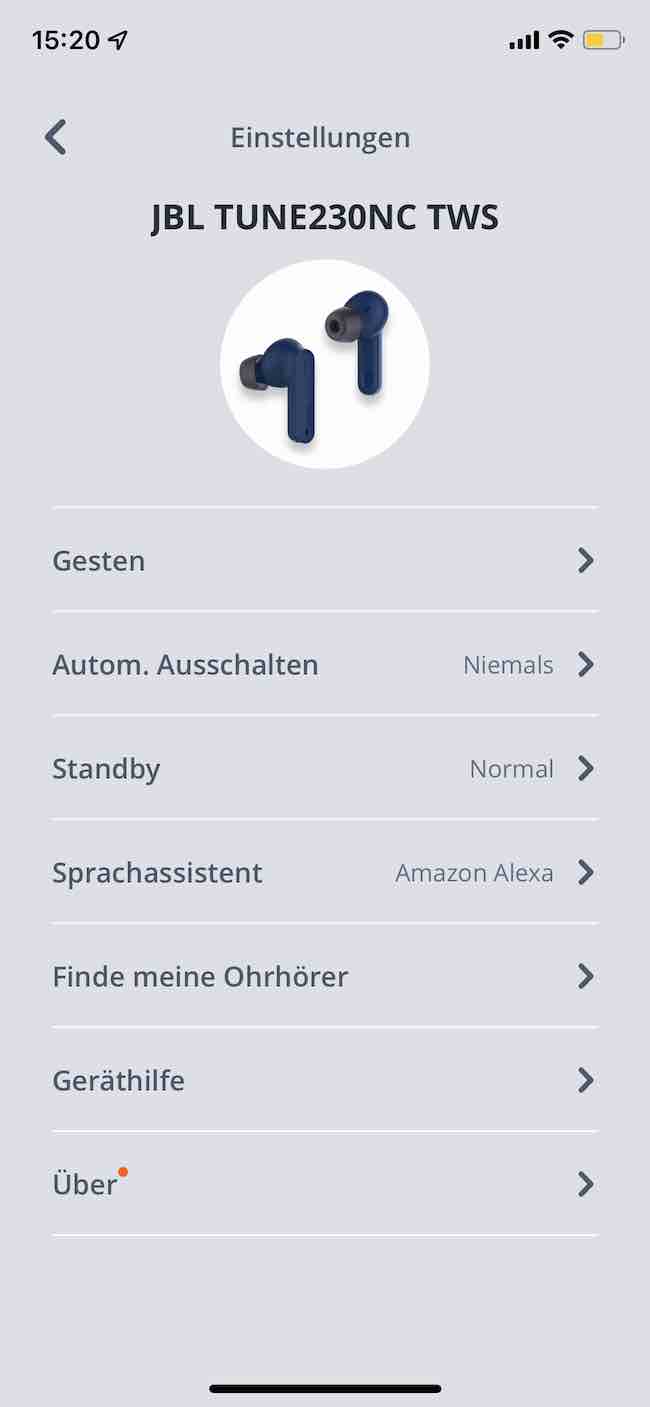STEREO GUIDE verdict
+ very rich, differentiated sound
+ astonishing SPL and with great punch
+ practical ANC
+ useful app with equalizer
- could sound a bit more refined
- Touch control a bit fiddly
-
Sound: Tonal Balance / Transparency7.2
-
Sound: Bass / Dynamics8.8
-
Ease-of-use / Connectivity9.2
-
Price/Performance9.7
True wireless ear buds are increasingly popular, and getting more and more affordable. Offering excellent sound quality and being produced by renowned brands, there is a lot of competition well under 100 dollars. With one exception: models offering a serious active noise cancelling technology are still more expensive. The JBL Tune 230NC TWS is promised to be a dealbreaker offering all key features of the more expensive models without a sacrifice in terms of sound quality. On top you get an impressive battery life of up to 10 hours without and 40 hours with recharging.
The shape reminds of the lollypop design made popular by Apple, with very light at (5.1 grams) earbuds being extended by a small stick. JBL’s stick is a bit wider, and the surface gives an impression that at this pricepoint posh luxury was obviously not a primary development goal. The sporty outfit is underlined by an IPX4 splash water protection, so do not be afraid of immediate defects when being used in rough conditions. The set is available in four colours, with pastel blue and desert beige, along with black and white, following actual trends.
High Tech at bargain price
JBL puts a lot of emphasis in marketing on a dynamic and deep bass response. This in technical terms means increased demands on the driver and power amplifier, especially when active noise cancelling (ANC) comes into consideration. Inside the JBL Tune 230NC TWS we find the 6 mm drivers, which should provide enough power reserve to fight external noise. Four mics support the algorithm in calculating the anti-noise, but should also ensure superior speech quality when answering phone calls.
The noise-cancelling can also be turned off if necessary or switched to transparency mode, which makes it easier to follow announcements from the outside world or conversations without taking the earbuds out. Of course, both buds have to fit tightly to the ear canal, and three different sized adaptors should ensure that for most ears. Selected the right one is supported by the free JBL My Headphones app from JBL.
The charging case is a bit thicker, as we know it from JBL, but still quite ergonomic due to its rounded shape. Like Apple Airpods, the two earbuds are inserted with the stick first and can be securely placed and removed without fumbling.
Bluetooth: the way to connect
Streams are coming in via Bluetooth 5.2, whereby JBL does not the potentially higher-quality audio codecs like AAC or Apt-X, presumably for cost reasons. For this, the app is supposed to help establish the best possible connection between earphones and smartphone. Users can choose between standard mode for extra reliable connection even when source and transducers are some meters away from each other. Audio mode for best music playback or Video mode for minimum-latency synchronization.




Full range of features via app
JBL did not skimp on the controls, on the contrary: The matching app My JBL Headphones offers an attractive bunch of features, such as a 10-band graphic EQ. This is calling for quite some experience, so ask a befriended recording engineer if necessary. Or go for the preset curves for jazz, vocal, bass, club and studio. However, you can also save your own EQ presets.
Battery status of both the earbuds and the reserve case can be monitored in the app, as well as it is offering the Bluetooth mode to be selected. Thus, either maximum data rate and thus the potential music quality can be prioritized, but optionally also realiability or the low-latency, which is useful for games and videos.
In addition, the two touch surfaces on the earbuds can be assigned various functions. However, you have to get used to the position of the sensitive sensors and the differentiation of several commands, and still might end up with a misfunction. After all, the functions can not only be displayed in the My JBL Headphones app, but also configured according to individual needs.
Both popular voice recognition technologies Google Assistant and Amazon Alexa are supported without any flaws. We would go for a combination of touch sensors, app and voice control.
Do the JBL Tune 230NC TWS deliver both noise cancelling and sound quality?
The JBL Tune 230NC TWS provide a pretty decent acoustic that is perfectly sufficient for relaxed listening pleasure without excessive SPL. Without music, environmental sounds and voices come through relatively clearly even with transparency mode being deactivated. Thus, the JBL are not necessarily the earbud of preffereed choice to forget about the world around you while sleeping on an airplane. It is more suitable for background music in urban environments.
They offer with secure, yet comfortable fit in the ear canals even when exercising in outdoor use. The sound reproduction of the JBL Tune 230NC TWS seemed surprisingly mature for a pair of affordable earbuds. The bass is really rich, but still clean and contoured. The low-frequency reproduction reaches amazingly low and offers a pretty good punch. So lovers of electronic beats and real drums will both love the JBLs. However, as is often the case with in-ear headphones, the ear pads play the decisive role in enjoying the full bass splendor.

Be careful with adaptors
For me personally, the JBL Tune 230NC TWS sounded a bit slim using the pre-mounted medium adaptors. Some older people might even like it that way – especially since it ensures a particularly comfortable fit without any impression of pressure. The resulting sound characteristic is universally suitable for all types of music and can be enjoyed for a long time without fatigue. But you deprive yourself of all the fun. With the right adaptors (in this case: large) and a tight fit, the JBL lives up to its brand fame for PA sound at rock and pop festivals.
And we are talking about the bis ones, with great SPL reserves, full-bodied punch and surprisingly extensive dynamic range. This overall rich, but by no means boomy or bloated bass underlines the transparent, at the given pricepoint surprisingly differentiated midrange reproduction in conjunction with good high-frequency resolution, which is offered without harshness. It is true that one should not expect a silky smooth high-end flair from the Tune 230NC in terms of voice reproduction and could wish for a tiny bit more clarity. In its class, however, it is undeniably a big hit. In itself, JBL succeeded in creating a decidedly coherent, neutral tonal balance that is hard to beat at this pricepoint. Thus, the Tune 230NC meets all basic needs for a wide variety of musical tastes and applications.
Conclusion and alternatives to the JBL Tune 230NC TWS
The current affordable price, long battery life and practical noise-cancelling make the JBL Tune 230NC TWS a clear highlight. It doesn’t have much competition at the moment, at least among the renowned audio brands. Those who want a bit more audiophile sound quality and even more effective noise-canceling will probably be happy to pay the extra bucks for the Panasonic RZ-S500WE. However, the JBL also makes it clear in a direct comparison that the Panasonic cannot quite keep up in terms of battery life and dynamics – and listening fun!
Specifications JBL Tune 230NC TWS
- Retail Price: 95 dollars
- Type: In-Ear
- Transducer principle: Dynamic
- Weight: 5.1 g
- Features: Bluetooth 5.2, TWS Active Noise-Cancelling, app control, 4 microphones, Amazon Alexa
- More at: www.jbl.com










